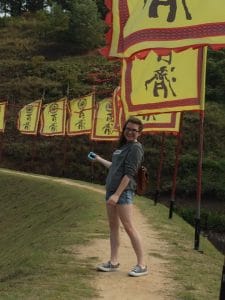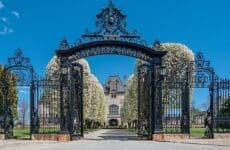By Lily Jones | Arts and Entertainment Editor

Every year hundreds of thousands of college students across the nation choose to study abroad, traveling to a new school in a foreign country to live and learn there for weeks, months, or even years at a time. The most popular places for American students to study abroad are mostly located in Europe, with England and Italy being the top two destinations. Many students who attend Salve Regina tend to lean toward these countries as well, with large numbers consistently being sent to locations like Oxford and Florence. However, Salve student Michelle Gregoire ’17 decided that the European route wasn’t for her. Instead, she opted to spend her fall 2015 semester in Asia- in Seoul, South Korea, to be exact.
Gregoire, a junior, cited a variety of reasons for her choice to study at Konkuk University located in the Kondae area of the Gwang-jin-gu region in Seoul, South Korea’s capital city and social and economic hub.
“My brother was in the military [and used to be stationed at] the army base there, so that’s when I first heard about South Korea,” she said. “And also, the Shotokan karate club here got me interested in martial arts, and South Korea kind of just caught my interest. I also really like the pop culture.”
Gregoire lived in a dorm on campus with a mixture of other international and Korean students. Her time aboard was made possible by the Salve Regina Office of International Programs, as well as the outside program International Studies Abroad, which provided extra activities and trips for her and other students to participate in while in Korea.
“I would wake up and go get breakfast, which was usually soup and rice, so that took a while to get used to,” Gregoire said of Korean dorm life. She said that her school was located in close proximity to an amusement park, as well as to the Seoul fashion district, very different from her experiences at Salve.
A biology major and chemistry minor, Gregoire’s science studies didn’t stop while she spent four months in Asia. She took five classes, including politics, molecular biology, environmental soil physics, biochemistry, and of course, Korean language. Aside from her language course, all of her classes were taught in both the native tongue and in English.
“A lot of times the professor would [teach] in Korean first and then say it in English,” recalled Gregoire. “The classes were the same size, but they focused a lot more on memorization. You didn’t have homework; it was more like you had the midterm and the final, but then those were your only grades, so they mattered a lot.”
Knowing that most Asian cultures put a lot of pressure on good grades, Gregoire was originally worried about the difficulty level of her courses.
“In Korea they have a high suicide rate because of the stress that is placed on the high schoolers, so I was expecting that a lot of the college students would be really really dedicated,” she said. “A lot of them were, but after they passed the really hard tests some of them think that they’re done, that they got into college so they don’t have to try as hard. So, it was interesting to see that type of culture, because here you party in high school and go to college to work hard, so it was kind of the opposite there.”
In addition to her academics, Gregoire also enjoyed the Korean pop culture, which plays a huge role in South Korea’s national identity. Korean media products are spread internationally through the globalization movement called the Korean wave, or “hallyu,” and many of their television shows and pop songs are enjoyed by neighboring Asian nations as well as in the U.S. and around the world.
“Every time you went out [in Seoul] you heard the K-pop music being played,” Gregoire said. “In the second week that I was at the school the band Day6 actually came to visit, which was really cool. I didn’t actually get to see because there was too many people, but I did actually get to hear it from my dorm, which was neat.”
She also remembered going to the Gangnam mall one day and running into Ji Chung-Wook, a famous actor in several K-Dramas, South Korea’s version of soap opera television shows. While Gregoire experienced K-pop and K-dramas as essential parts of South Korean pop culture, she was also exposed to social culture. Comprised of Confucian ideals, she saw that respect for elders, superiors, and family members was considered extremely important in the eyes of Korean citizens.
“Every time you greeted someone you had to bow to them, which was really different,” she said. “And then with the respect to age difference, which is a big thing in Confucian culture, there were certain spots on the subway that you couldn’t sit unless you were an elderly person. So they were reserved for elderly and pregnant ladies, and a lot of times we would see foreigners sitting there so we’d have to go tell them that ‘you can’t do that, it’s rude to do that.'”
Highlights of her trip included visiting Bukhansan National Park and hiking Mount Dobongsan, as well as traveling by bus to the DMZ, the demilitarized zone- a highly dangerous buffer zone that separates South Korea and North Korea. Gregoire remembered being stopped at a variety of security checkpoints where soldiers would check her passport and alien registration card, as non-military Korean citizens are not actually allowed to enter the zone.
“It was the scariest thing I’ve probably ever done,” she said. “Once we got past the checkpoints we were in this area and it was just farmland, and we could see tons of wildlife because like nobody actually lives out there except for farmers who need the soldiers to go with them when they work on the fields.”
Gregoire also drove through what are known as propaganda camps. She said that the two camps, one owned by the South and one by the North, are little villages with few residents that exist next to each other at the DMZ. Not many people live in the camps, and Gregoire said that their purpose is to show the other that they are the country with the better quality of life, since both are constantly monitoring each other from watchtowers and bunkers.
“North Korea, at their propaganda camp, they actually have one of the tallest flag posts in the world, which was really funny to see because it’s like a competition between the two countries,” she said. “But it was really eery, because you just saw huge eagles, like four-foot-tall eagles and vultures flying around there.”
Gregoire actually got to step over the physical demarkation line separating the two countries while in one of the DMZ buildings. “It was really scary because it was dead silent and you knew that they had cameras and guns pointed at you,” she said. “They told us not to make hand gestures, or to point at North Korea, or be loud or anything.”
Given her unique and exciting experience going to school in South Korea, Gregoire said that she would love to return one day. She recommended South Korea as a study abroad destinations, but also suggests doing as much research as you can before committing to a semester away from home.
“If anyone is interested in Asia or South Korea, if they do a lot of research and they want to do it, they totally should,” encouraged Gregoire. “Just go for it.”














